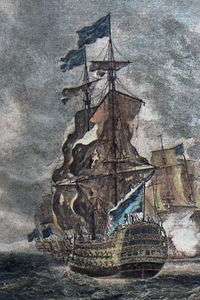HMS Namur (1756)
 HMS Namur at the Battle of Lagos | |
| History | |
|---|---|
| Name: | HMS Namur |
| Ordered: | 12 July 1750 |
| Builder: | Chatham Dockyard |
| Launched: | 3 March 1756 |
| Fate: | Broken up, 1833 |
| Notes: | |
| General characteristics [1] | |
| Class and type: | 1750 amendments 90-gun second rate ship of the line |
| Tons burthen: | 1814 bm |
| Length: | 175 ft (53.3 m) (gundeck) |
| Beam: | 48 ft 6 in (14.8 m) |
| Depth of hold: | 20 ft 6 in (6.2 m) |
| Propulsion: | Sails |
| Sail plan: | Full rigged ship |
| Armament: |
|
HMS Namur was a 90-gun second rate ship of the line of the Royal Navy, built at Chatham Dockyard to the draught specified by the 1745 Establishment as amended in 1750, and launched on 3 March 1756.[1]
Namur was the flagship of Edward Boscawen Vice Admiral of the Blue in the capture of Louisburg in 1758. General James Wolfe had sailed across the Atlantic in Namur on this occasion before his capture of Quebec. Also on this journey was 6th Lieutenant Michael Henry Pascal with his slave and servant Olaudah Equiano who at that time was called Gustavus Vasser,[2] his slave name given him by Pascal. Equiano in his book [3] wrote that the ceremony of surrender was "the most beautiful procession on the water I ever saw", and gives fuller details.[4]
Namur was the flagship of Admiral Sir George Pocock in the Battle of Havana (1762).
Namur fought in the Battle of Cape St Vincent (1797) under the command of Captain James Hawkins-Whitshed. Namur was astern of HMS Captain, under the command of then Commodore Horatio Nelson, at the beginning stages of the battle.[5]
Namur was razeed to a 74-gun ship in 1805, and was placed on harbour service in 1807. She remained in this role until 1833, when she was finally broken up.[1]
Some of Namur's timbers were used to support the floor of the wheelwright's workshop at Chatham Dockyard. They were rediscovered there in 1995 and identified in 2003.[6][7] The restored timbers form the centrepiece of the "Command of the Oceans" gallery at the Chatham Historic Dockyard museum opened in 2016.[8]
Notable crewmembers
- The marine painter Clarkson Stanfield served on board the ship, after being pressed into the Royal Navy in 1808. He was discharged on health grounds in 1814.
- One of Namur's captains was Charles Austen, a brother of Jane Austen.[9]
- Olaudah Equiano, a former African slave who was active in the British abolitionist movement, served as a powder monkey on Namur.[10]
Notes
- 1 2 3 Lavery, Brian0 (1983). The Ship of the Line - Volume 1: The development of the battlefleet 1650-1850. London: Conway Maritime Press. p. 174. ISBN 0-85177-252-8.
- ↑ TNA ADM 36/6252
- ↑ Equiano, Olaudah (2003). The Interesting Narrative, and Other Writings. Penguin. ISBN 9780 142437162.
- ↑ Baines, Stephen (2015). Captain Cook's Merchant Ships; Freelove, Three Brothers, Mary, Friendship, Endeavour, Adventure, Resolution and Discovery. The History Press. pp. 150–151. ISBN 9780 750962148.
- ↑ Adkin, Mark (2005). The Trafalgar companion: a guide to history's most famous sea battle and the life of Admiral Lord Nelson. London: Aurum Press. p. 163. ISBN 978-1845130183.
- ↑ "Fighting ship's identity revealed in Chatham Dockyard". BBC News. 17 August 2012.
- ↑ Atkinson, Daniel Edward (2007). Shipbuilding and timber management in the Royal Dockyards 1750-1850: an archaeological investigation of timber marks (Ph.D. thesis). University of St Andrews.
- ↑ Kennedy, Maev (25 May 2016). "Shiver me timbers! Remains of fabled warship HMS Namur dock in museum". The Guardian.
- ↑ Spilman, Rick (20 August 2012). "Timbers from Jane Austen's Brother's Ship, HMS Namur, Found under Floorboards at Chatham Historic Dockyard". Old Salt Blog.
- ↑ Reuben, Paul P. "Olaudah Equiano (1745-1797)". PAL: Perspectives in American Literature- A Research and Reference Guide.
Further reading
- Chapter III and Chapter IV of The Interesting Narrative of the Life of Olaudah Equiano, or Gustavus Vassa, the African, at Wikisource, contain an account of the author's service aboard HMS Namur.